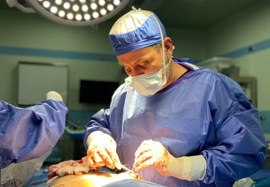
A neck lift, or lower rhytidectomy, is surgically performed to decrease visible signs of aging around the neck and jaw. The primary goals of this procedure are the following:
- To relax the skin and excess fat on the lower face that makes up the jowls
- To loosen neck skin
- To reduce excess fatty deposits under the chin
- To improve issues of muscle banding in the neck that result in abnormal shaping
- To help with massive weight loss also known as the Ozempic face and neck
CAUSES OF SAGGING NECK
Many of us have looked in the mirror and seen that our jaw line is not as defined as it once was. Creating a smooth jaw line can make a person seem more youthful and rid of the “turkey gobbler syndrome” (or look of the sagging neck). The causes of sagging neck vary and may be due to heredity, a reaction to gravity, environmental factors, massive weight loss also known as the Ozempic face and neck effect as well as stress.
OZEMPIC FACE AND NECK
The term “Ozempic face and neck”, although not a medical term, has become popular for describing the appearance of the face and neck after weight loss – specifically weight loss that happens after taking Ozempic or similar medications like Trulicity, Mounjaro, Wegovy, Saxenda, etc. – or just from rapid weight loss in general.
The term refers to a hollowness in the cheeks or extra skin in the neck that can show up when you lose fat in your face.
Common concerns: After losing 40 to 50 pounds, many patients are concerned that their face looks gaunt, almost too thin, and a hollow appearance under the eyes or in the cheeks can make them look older.
Ozempic face and neck surgery options:
- Injections: Lasting a few months to more than a year, dermal fillers such as Juvederm or Restylane Lyft can restore facial fullness for a smoother, more youthful look. We can also consider fat grafting, which removes fat from the hips or abdomen with liposuction techniques and injects it into the cheeks, under the eyes, or around the lips, chin, mouth, or temples.
- Face lift: Dr. Suarez assess your face, neck and eyebrows to evaluate your unique facial structure giving you a more rejuvenated appearance rather than simply tightening the skin.
- Neck lift: Also called a rhytidectomy, a neck lift reduces excessive skin, double chin, and “jowls.” Dr. Suarez will carefully remove and redistribute skin, fat, and muscle tissue using precise incisions that can be hidden within the hairline, back of the neck, and behind the ears.
CANDIDATES
Most people begin to notice the sagging of their neck at around the age of 30. The procedure itself is performed primarily on people between the ages of 30 and 70. Now a days this type of surgery is often performed on patients that have undergone bariatric surgery, have lost massive amount of weight due to medication like Ozempic, Trulicity, Mounjaro, Wegovy, Saxenda or other, as well as through dieting and exercise. The quality of a neck lift and improvement of a person’s sagging neck often has to do with the person’s skin quality; therefore, the best candidates for neck lift are usually young or middle-aged, have minimal to moderate amounts of excess skin, and also have mild to moderate subplatysmal fat. This is the fat that is under broad thin layer of muscle that is on each side of the neck.
In addition, before electing to have a neck lift, Dr. Suarez will discuss the following factors with his patients:
- How will the neck lift work with my skin type?
- How will the neck lift complement my particular jaw structure?
- How does my medical history affect the risks and benefits of this procedure?
- Does someone with my ethnic background necessarily benefit as well from a neck lift than those of other ethnic backgrounds?
- How, as an individual, will my healing time fare after the surgery?
Even though a neck lift cannot stop the aging process, it can possibly boost one’s self-confidence. Discussing your individual factors that will affect your neck lift is important to keep a realistic attitude about the surgery.
THE DECISION TO HAVE A NECKLIFT
During your preliminary consultation, Dr. Suarez must examine the structure of your neck and face. In this exam, he will also study your skin’s elasticity, its texture, and its color. He will take photographs of your face and neck.
The decision to have a neck lift can only be made after a thorough and in-depth discussion with Dr. Suarez. Before scheduling the surgery, you should meet with him to discuss your medical history, such as your health conditions, allergies, use of medications as well as alcohol and tobacco use. You should also mention if you are taking any herbal supplements. In addition, it is important to discuss your mental and emotional preparedness for surgery itself. The doctor and you must talk realistically about your expectations.
A number of risk factors must also be discussed. You may, for example, be at-risk for complications during surgery if you experience any of the following conditions/situations:
- You are a smoker.
- You have high blood pressure.
- You have a deficiency, such as anemia.
- You are prone to blood clots.
Once completing a thorough and honest consultation with Dr. Suarez, you may then discuss the process of surgery itself.
COST
The costs of surgery may differ because each individual is unique. Dr. Suarez will assess each case individually. Important to note that the costs of surgery does not reflect the additional costs of anesthesia, operating room costs, and other hospital expenses or surgeons’ fees.
RECOVERY
For most patients, recovery takes from two to four weeks. Some patients may return to work as early as two weeks after surgery. Scars may not be visible immediately; however, they may slowly mature. In some case, persistent scarring may occur; however, makeup can conceal such scarring and total healing will eventually happen. Patients must also be aware that the aging process does not stop just because of neck lift surgery, and tissues may relax during the first weeks after surgery. It is essential to keep follow-up appointments based on Dr. Suarez’s recommendations so he may monitor your healing process.









